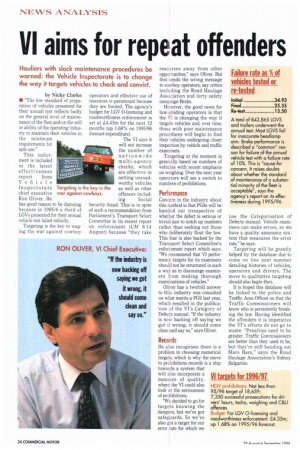VI aims for repeat offenders
Page 26

If you've noticed an error in this article please click here to report it so we can fix it.
Hauliers with slack maintenance procedures be warned: the Vehicle Inspectorate is to change the way it targets vehicles to check and convict.
by Nicky Clarke • "The low standard of preparation of vehicles presented for their annual test reflects badly on the general level of maintenance of the fleet and on the will or ability of the operating industry to maintain their vehicles to the minimum requirements for safe use."
This indictment is included in the latest effectiveness report from Vehicle Inspectorate chief executive Ron Oliver. He has good reason to be damning because in 1995/6 a third of LGVs presented for their annual vehicle test failed initially.
Targeting is the key to waging the war against cowboy operators and effective use of resources is paramount because they are limited. The agency's budget for WV 0-licensing and roadworthiness enforcement is set at £4.43m for the next 12 months (up L68% on 1995/96 forecast expenditure).
The VI says it will not increase the number of nationwide multi-agency checks, which are effective in netting unroadworthy vehicles as well as other offences includ ing Social Security fraud. This is in spite of such a recommendation from Parliament's Transport Select Committee in its recent report on enforcement (CM 8-14 August) because "they take resources away from other opportunities," says Oliver. But this sends the wrong message to cowboy operators, say critics including the Road Haulage Association and lorry safety campaign Brake.
However, the good news for law-abiding operators is that the VI is changing the way it targets vehicles and, over time, those with poor maintenance procedures will begin to find their vehicles undergoing closer inspection by vehicle and traffic examiners.
Targeting at the moment is generally based on numbers of vehicles with recent emphasis on weighing. Over the next year operators will see a switch to numbers of prohibitions.
Performance
Concern in the industry about this method is that PG9s will be handed out irrespective of whether the defect is serious or trivial just to notch up numbers rather than seeking out those who deliberately flout the law. This fear is also backed by the Transport Select Committee's enforcement report which says: "We recommend that VI performance targets for its examiners should not be structured in such a way as to discourage examiners from making thorough examinations of vehicles."
Oliver has a twofold answer to this: industry was consulted on what merits a PG9 last year, which resulted in the publication of the VI's Category of Defects manual. "If the industry is now backing off saying we got it wrong, it should come clean and say so," says Oliver.
Records
He also recognises there is a problem in choosing numerical targets, which is why the move to prohibitions records is a step towards a system that will also incorporate a measure of quality, where the VI could also look at the seriousness of prohibitions.
"We decided to go for targets knowing the dangers, but we've got safeguards. So we've also got a target for our error rate for which we use the Categorisation of Defects manual. Vehicle examiners can make errors, so we have a quality assurance system that measures the error rate," he says.
Targeting will be greatly helped by the database due to come on line next summer detailing histories of vehicles, operators and drivers. The move to qualitative targeting should also begin then.
It is hoped this database will be linked to the police and Traffic Area Offices so that the Traffic Commissioners will know who is persistently break-. ing the law. Having identified the offenders it is imperative the VI's efforts do not go to waste: "Penalties need to be greater. Traffic Commissioners are better than they used to be, but they're still handing out Mars Bars," says the Road Haulage Association's Sidney Balgarnie.
VI tarots for 1996/97
HGV prohibitions: Not less than 95/96 target of 18,659;
7,350 successful prosecutions for drivers' hours, tacho, weighing and C&U offences.
Budget: For LGV 0-licensing and roadworthiness enforcement: 24.35m; up 1.68% on 1995/96 forecast.








































































































